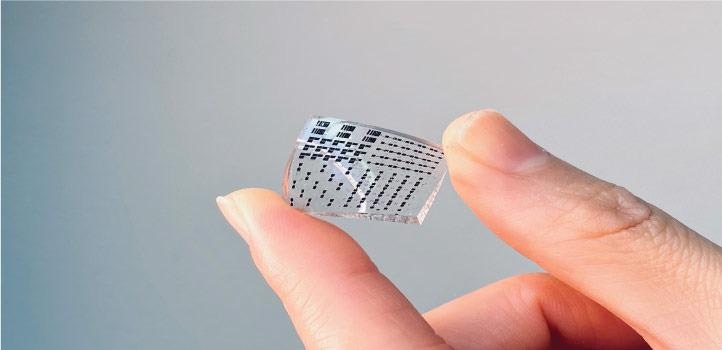Nov 30 2020
A material with the ability to mimic the human skin in terms of sensitivity, stretchability, and strength could help collect biological information in real time.
 KAUST researchers have developed a durable “electronic skin” that can mimic natural functions of human skin, such as sensing temperature and touch. Image Credit: © 2020 KAUST.
KAUST researchers have developed a durable “electronic skin” that can mimic natural functions of human skin, such as sensing temperature and touch. Image Credit: © 2020 KAUST.
Electronic skin, also known as e-skin, could have a crucial role to play in the next-generation prosthetics, artificial intelligence, soft robotics, and personalized medicine.
The ideal e-skin will mimic the many natural functions of human skin, such as sensing temperature and touch, accurately and in real time.
Yichen Cai, Postdoc, KAUST
But it is quite difficult to make appropriately flexible electronics that can execute such delicate tasks while enduring the scrapes and bumps of daily life, and it is essential to carefully engineer each material involved.
A majority of the e-skins are created by layering an active nanomaterial (the sensor) on a stretchable surface that can be fixed to human skin. But the link between such layers becomes too weak usually, which decreases the material’s sensitivity and durability. On the other hand, if it is too strong, its flexibility is affected, rendering it more prone to crack and break the circuit.
The landscape of skin electronics keeps shifting at a spectacular pace. The emergence of 2D sensors has accelerated efforts to integrate these atomically thin, mechanically strong materials into functional, durable artificial skins.
Yichen Cai, Postdoc, KAUST
Led by Cai and his collaborator Jie Shen, a research team has developed a durable e-skin by making use of a hydrogel reinforced with silica nanoparticles as a robust and stretchy substrate as well as a 2D titanium carbide MXene as the sensing layer. The substrate and the sensing layer are bound together by highly conductive nanowires.
“Hydrogels are more than 70 percent water, making them very compatible with human skin tissues,” explained Shen. The researchers prestretched the hydrogel in all directions, used a layer of nanowires, and then cautiously regulated its release to make conductive pathways to the sensor layer that continued to be intact even when the material was extended to 28 times its actual size.
The prototype e-skin developed by the team can sense objects from 20 cm away and react to stimuli within one-tenth of a second. When it is utilized as a pressure sensor, it can differentiate handwriting written upon it.
The e-skin continued to work well even after 5,000 deformations, recovering within a quarter of a second every time.
According to Shen, “It is a striking achievement for an e-skin to maintain toughness after repeated use, which mimics the elasticity and rapid recovery of human skin.”
This kind of e-skin can track a range of biological data, like variations in blood pressure, which could be detected from vibrations in the arteries, and movements of large limbs and joints. Then, this data can be shared and stored on the cloud through Wi-Fi.
“One remaining obstacle to the widespread use of e-skins lies in scaling up of high-resolution sensors,” added group leader Vincent Tung; “however, laser-assisted additive manufacturing offers new promise.”
We envisage a future for this technology beyond biology. Stretchable sensor tape could one day monitor the structural health of inanimate objects, such as furniture and aircraft.
Yichen Cai, Postdoc, KAUST
Journal Reference:
Cai, Y., et al. (2020) Mixed-dimensional MXene-hydrogel heterostructures for electronic skin sensors with ultrabroad working range. Science Advances. doi.org/10.1126/sciadv.abb5367.